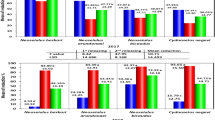Abstract
In Europe in the last few years increasing infestations of oilseed rape and turniplike rape by the winter stem weevil,Ceutorhynchus picitarsis Gyll. were registered. The entering ofC. picitarsis into the rape crops in autumn was recorded with yellow sticky traps. Cabbage stem flea beetles (Psylliodes chrysocephala) were captured simultaneously. With special cagetraps it was demonstrated that the rape winter stem weevil spends the summer time in the leaf-layer of the soil in forest edges. We were able to demonstrate thatC. picitarsis can be controlled together withP. chysocephala with Pyrethroids.
Zusammenfassung
In den letzten Jahren wurde in Europa ein zunehmendes Auftreten des Schwarzen Triebrüßlers,Ceutorhynchus picitarsis Gyll. beobachtet. Der Einflug der Käfer im Herbst in die Raps- und Rübsenfelder kann mit gelben Leimtafeln überwacht werden. Etwa gleichzeitig erfolgt auch die Einwanderung des ErdflohesPsylliodes chrysocephala L. Mit Hilfe von Schlupfkästen wurde nachgewiesen, daß der Triebrüßler den Sommer in den Bodenstreu von Waldrandpartien verbringt.
Spritzversuche zeigten, daß der Triebrüßler zusammen mit dem Erdfloh sehr gut mit Pyrethroiden bekämpfbar ist.
Similar content being viewed by others
Literaturverzeichnis
Büchi, R.;Ridly, P., 1983: Die Bekämpfung des Schwarzen Triebrüßlers,Ceutorhynchus picitarsis Gyll. als Schädling in Rübsenkulturen im Berner Seeland. Mitt. Schweiz. Landw.31, (9), 217–223.
Büchi, R.;Ridly, P., 1984: Bekämpfung des Schwarzen Triebrüßlers. Raps2 (4), 166–167.
Dosse, G., 1951a: Starkes Auftreten vonCeutorhynchus picitarsis Gyll. an Raps und Rübsen in Württemberg. Vortrag Dtsch. Ges. angew. Ent. München 3. und 4. 10. 1949, Sonderheft.
Dosse, G., 1951b: Versuche zur Bekämpfung des Schwarzen Triebrüßlers (Ceutorhynchus picitarsis Gyll.). Anz. f. Schädlingskde.24, 146–152.
Dosse, G., 1952: Zur Biologie und Morphologie des Schwarzen Triebrüßlers,Ceutorhynchus picitarsis Gyll. mit differential-diagnostischen Angaben zur Unterscheidung der Larven vonCeutorhynchus napi Gyll.,C. quadridens Panz. undC. picitarsis Gyll. Z. ang. Ent.34, 303–312.
John, M.E.; Vaughan, J.; Evans, E.J., 1984: Control of pests and diseases of oilseed rape. Booklet, Min. of Agric., Fish. and Food, No. 2387.
Jourdheuil, P., 1969: A propos du charançon noir h'hiver. Bull. Cetiom No. 38, 23–26.
König, K., 1984: Rapsschädlinge im Herbst. Raps2 (3), 100–102.
Maceljski, M.;Balarin, I.;Danon, V., 1980: Rezultati visegodisnjih proucavanja pojave i stetnosti insekata na uljanoj repici. Zastita bilja31 (4), 317–324.
Murbach, R., 1958: Le colza de la plaine du Rhône attaqué par un charançon peu connu:Ceutorhynchus picitarsis Gyll. Revue romande14 (10), 80–81.
Pouzet, A., 1982: Colza: Le charançon du bourgeon terminal. Phytoma No 341, 15–17.
Pouzet, A.;Ballanger, Y., 1984: Le piégeage des ravageurs du colza a l'automne. Phytoma362, 21–23.
Author information
Authors and Affiliations
Additional information
Mit 6 Abbildungen und 5 Tabellen
Rights and permissions
About this article
Cite this article
Büchi, R. Biologie und Bekämpfung des Schwarzen Triebrüßlers,Ceutorhynchus picitarsis Gyll. (Col., Curculionidae). Anz. Schadlingskde., Pflanzenschutz, Umweltschutz 59, 51–56 (1986). https://doi.org/10.1007/BF01905922
Issue Date:
DOI: https://doi.org/10.1007/BF01905922




